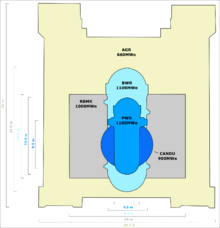Generation II reactor

A generation II reactor is a design classification for a nuclear reactor, and refers to the class of commercial reactors built up to the end of the 1990s.[1] Prototypical generation II reactors include the PWR, CANDU, BWR, AGR, and VVER.[1]
These are contrasted to generation I reactors, which refer to the early prototype of power reactors, such as Shippingport, Magnox/UNGG, Fermi 1, and Dresden.[1] The nomenclature for reactor designs, describing four 'generations', was proposed by the US Department of Energy when it introduced the concept of generation IV reactors.
The designation generation II+ reactor is sometimes used for modernized generation II designs built post-2000, such as the Chinese CPR-1000, in competition with more expensive generation III reactor designs. Typically, the modernization includes improved safety systems and a 60-year design life.
Generation II reactor designs generally had an original design life of 30 or 40 years. This date was set as the period over which loans taken out for the plant would be paid off. However, many generation II reactor are being life-extended to 50 or 60 years, and a second life-extension to 80 years may also be economic in many cases.[2] By 2013 about 75% of still operating U.S. reactors had been granted life extension licenses to 60 years.[3]
Fukushima Daiichi's three destroyed reactors are Mark I Boiling water reactors (BWR) designed by General Electric. In 2015, unit 2 at the Watts Bar Nuclear Generating Station is likely to be the last generation II reactor to come online.
See also
References
- 1 2 3 Jamasb, Tooraj; William J. Nuttall; Michael G. Pollitt (2006). Future electricity technologies and systems (illustrated ed.). Cambridge University Press. p. 203. ISBN 978-0-521-86049-9.
- ↑ "No reason why NPPs cannot live beyond 60". Nuclear Engineering International. 1 October 2010. Retrieved 14 October 2010.
- ↑ "Renewal a bridge to replacement". World Nuclear News. 19 December 2013. Retrieved 21 December 2013.